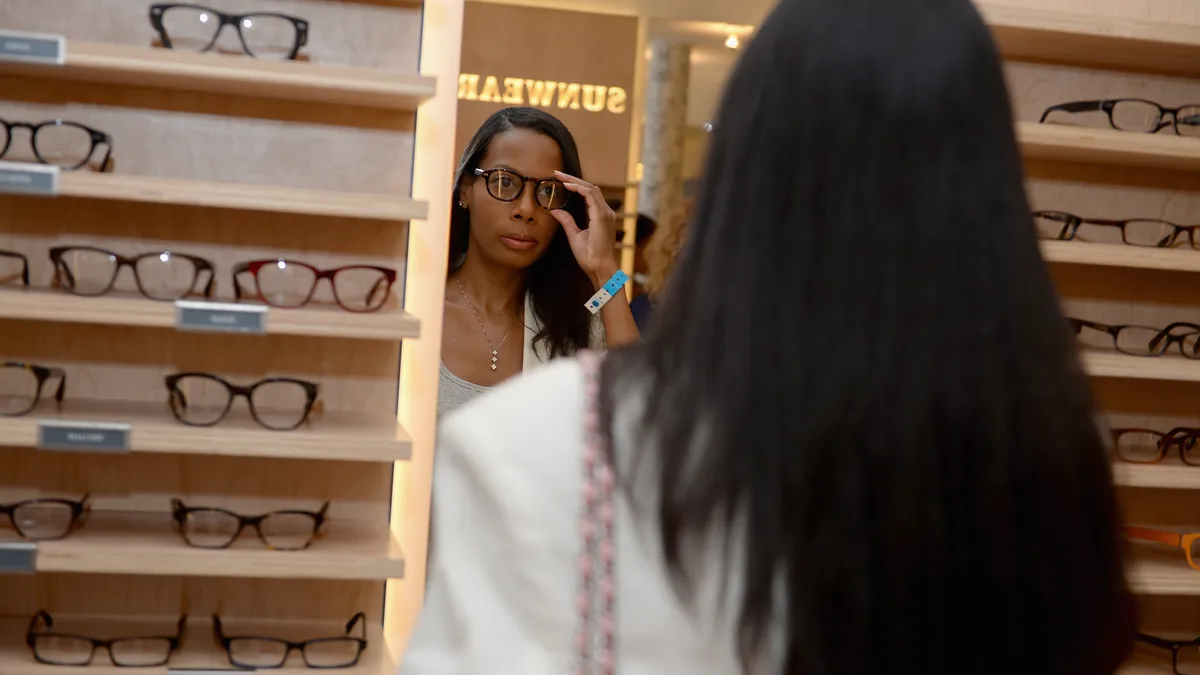E-commerce companies benefited at the onset of the pandemic as consumers redirected spending from stores to online in an attempt to limit the spread of the coronavirus.
But as vaccines have helped push consumers to shop in person again and shift spending to other areas outside of retail, can online retailers maintain the gains they made last year?
We took a look at how Q3 played out for digitally native retailers, many of which are reporting earnings for the first time since making their public market debuts.
Etsy
Revenue: $532.4 million | YoY: +17.9%
Active customers: 96 million | YoY: +37.8%
Operating income: $83.7 million | YoY: -29.1%
Net income: $89.9 million | YoY: -2%
Etsy benefited in the early days of the pandemic as many of its makers began producing and selling masks — an item in high demand. The marketplace has maintained its sales momentum, even lapping last year's sales numbers by double digits. Etsy marketplace gross merchandise sales increased 12.4% from last year to $2.7 billion; excluding face masks, it grew 23.7%.
The company grew its active seller base to 7.5 million, up 102.7% from the year-ago period.
"Our excellent third quarter results further reflect that we're moving the needle on frequency, and that many of the millions of buyers who found, or re-found Etsy during the pandemic are sticking with us, and performing even better than historical cohorts," CEO Josh Silverman said in a statement.
Wayfair
Revenue: $3.1 billion | YoY: -18.7%
Active customers: 29.2 million | YoY: +1.5%
Operating loss: $69.8 million
Net loss: $78 million
Citing shifts in consumer spending — from online to brick and mortar, and from retail to experiences — Wayfair's net income fell nearly 20% in the third quarter.
Like other retailers selling in the home category, Wayfair experienced a sales boost at the beginning of the pandemic as consumers began investing more in their personal spaces. But as demand in the category wanes, the DTC home retailer's sales are suffering.
Still, Wayfair was able to grow its customer base over last year's heightened figures and more than 50% from 2019.
Qurate
Revenue: $3.1 billion | YoY: -7%
Operating income: $274 million | YoY: -33%
Net income: $127 million | YoY: -62%
On an earnings call with analysts, CEO David Rawlinson — who stepped into the role Oct.1 — said the industry-wide supply chain challenges were a major reason for revenue declines in the retailer's third quarter. In Qurate's QxH unit, revenue declined 8% to $1.8 billion; QVC international revenue declined 3% to $699 million; and Zulily revenue declined 17% to $328 million. Revenue at Qurate's Cornerstone unit — which includes Ballard Designs, Frontgate, Grandin Road and Garnet Hill — increased 7% to $304 million.
Total customers over the last 12 months declined 1% at QxH to 11.1 million, 2% at Zulily to 5.3 million and remained flat at QVC International at 4.9 million.
ThredUp
Revenue: $63.3 million | YoY: +35%
Active customers: 1.4 million | YoY: 14%
Operating loss: $15.5 million | YoY: +46.4%
Net loss: $14.7 million | YoY: +33.7%
ThredUp announced it would end its styling box subscription and replace it with an algorithm-backed "Thrift the look" option, according to CEO and co-founder James Reinhart.
But despite this, the retailer grew its revenue double digits from last year and has largely been able to avoid the supply chain challenges plaguing the industry because it sources its goods domestically.
ThredUp has also been able to lean into its resale-as-a-service platform, saying that it's processed over 125 million secondhand items from 35,000 brands so far.
The RealReal
Revenue: $119 million | YoY: +53%
Active customers: 772,000 | YoY: +25.1%
Operating loss: $51.2 million | YoY: +22.9%
Net loss: $57 million | YoY: +31.3%
The RealReal was able to not only grow its revenue by over 50% year over year but compared to 2019, revenue grew by 46%.
"Our product supply has ramped nicely driven by at-home concierge appointments and our expanded retail footprint. Based on what we know today, we believe the operational and supply impacts to our business from COVID-19 are effectively behind us, and we are well-positioned for a strong holiday season," Julie Wainwright, founder and CEO of The RealReal, said in a statement. "Additionally, we believe The RealReal's unique business model is largely insulated from the supply chain shortages and certain ... inflationary impacts many retailers are experiencing."
Wainwright added that although the retailer has been affected by outside forces like staffing shortages and increased shipping costs, The RealReal has addressed this by diversifying its shipping, optimizing its last-mile delivery and focusing on automation, among other things.
Poshmark
Revenue: $79.7 million | YoY: +16%
Active customers: 7.3 million | YoY: +17%
Operating loss: $7.2 million
Net loss: $7.2 million
While supply chain challenges like shipping delays, high freight costs and product shortages have affected companies across the industry, Poshmark has been more protected than others because it focuses on domestically sourced secondhand goods.
And though its Q3 revenue increased over 15%, its outlook for the fourth quarter came below expectations, projecting revenue to be between $80 million and $82 million and adjusted EBITDA to be a loss of $7 million to $8 million.
A.K.A. Brands
Revenue: $161.8 million | YoY: +155.4%
Active customers: 3.1 million | YoY: +138.5%
Operating income: $1.2 million | YoY: -89.3%
Net loss: $10.1 million
A.K.A. Brands — whose portfolio of brands includes Princess Polly, Culture Kings, Mnml, Petal & Pup and Rebdolls — made its public trading debut in September. The company, established in 2018, is a brand accelerator for DTC brands.
"During the quarter our brands generated growth across all regions, especially in the U.S. where net sales increased 84% on a pro-forma basis," CEO Jill Ramsey said in a statement, adding that the company also saw strong growth in Australia despite lockdowns related to COVID-19. "Looking ahead, we will continue to accelerate the global growth of our brands by increasing customer awareness and leveraging our unique business model to drive long-term profitability and value."
While A.K.A. Brands posted a triple-digit revenue increase from last year, or a 44% increase adjusted for the acquisition of Culture Kings, the company swung to a loss in the quarter from a profit of $7.3 million in the same period last year.
Purple
Revenue: $170.8 million | YoY: -8.7%
Operating loss: $6.6 million
Net income: $2.1 million
Purple's sales slid from last year as it missed revenue expectations from Wedbush ($191 million) and consensus estimates ($198 million).
Purple CEO Joe Megibow called the results "disappointing," pointing to a longer-than-anticipated manufacturing backlog and lack of inventory as being major drivers to the sales decline. "Our lack of inventory impacted sales through all of our channels which are deeply interconnected. Specifically, delays in planned wholesale expansion, slower re-acceleration of existing wholesale door productivity, and a more prolonged build-back from the effect of marketing spend reduction in response to inventory shortages which in turn also impacted our digital business," Megibow said, adding that the company also missed opportunities related to pricing and cost management.
The DTC mattress brand, which benefited last year from selling in a home-related category, also swung to an operating loss from a profit of $24.3 million last year, though it also reported a net profit from a net loss of $87.2 million in 2020.
Olaplex
Revenue: $161.6 million | YoY: +81%
Operating income: $87 million | YoY: +98.3%
Net income: $56.6 million | YoY: +99.9%
Olaplex, which made its public debut in late September, grew its third quarter revenue by more than $72 million from last year, driven by its professional segment increasing 57.6% to $75 million, specialty retail rising 128.1% to $46.3 million and DTC growing 86.9% to $40.3 million.
For the fiscal year, the brand expects net sales to increase by about 107% to between $580 million and $588 million, while adjusted net income is projected to grow by around 103% to between $263 million and $268 million.
Hims & Hers
Revenue: $74.2 million | YoY: +79%
Active subscribers: 551,000 | YoY: +94.7%
Operating loss: $27.7 million | YoY: +732.9%
Net loss: $15.9 million | YoY: +171.5%
Hims & Hers at the beginning of this year went public via special purpose acquisition company, or SPAC, a form of exit that's gained steam lately.
In the third quarter, the brand grew its revenue and subscriber base, but its losses also widened and marketing expenses more than doubled to $38.3 million from $15.1 million last year. However, CEO and co-founder Andrew Dudum highlighted the company's customer acquisition costs remained in line with the second quarter, with marketing expenses increasing by just over $10 million.
"Not only did we deliver strong revenue growth in Q3, we did so while maintaining customer acquisition costs quarter-to-quarter, nearly doubling total subscriptions year-over-year, and delivering on strategic initiatives to catalyze future growth," Dudum said in a statement.
Bark
Revenue: $120.2 million | YoY: +39.1%
Active subscribers: 2.1 million | YoY: +39.4%
Operating loss: $15.4 million | YoY: +2,158.3%
Net income: $6.5 million
Bark, another retailer that went public recently by way of SPAC, has benefited over the last year as consumers turned to their pets — and began spending more on them — as a source of comfort during uncertain times.
"Bark continues to benefit from powerful secular and channel tailwinds, including growing dog ownership, increasing spending on pets, and an expanding share of pet sales occurring online," CEO Manish Joneja said in a statement.
During the retailer's second quarter, it added about 271,000 subscribers and grew its sales by nearly $34 million from last year, driven by a 41.7% increase to DTC revenues and a 20.8% rise to commerce revenues.
For the full year, Bark anticipates a 2% risk to the $516 million revenue guidance due to uncertainty around freight and shipping.
Digital Brands Group
Revenue: $2.2 million | YoY: +75%
Operating loss: $7.9 million | YoY: +133%
Net loss: $8.9 million | YoY: +128.3%
Digital Brands Group grew its revenue by 75% in the third quarter and CEO Hil Davis expects fourth quarter revenues to double on a sequential quarterly basis to $4 million.
During the quarter, the brand completed its acquisition of Stateside, an apparel business it announced it would buy in August for $10 million.
Warby Parker
Revenue: $137.4 million | YoY: +32%
Active customers: 2.15 million | YoY: +23%
Operating loss: $92 million | YoY: +122.8%
Net loss: $91.1 million | YoY: +119%
In its first earnings report since its direct listing in late September, Warby Parker exceeded its own revenue expectations. The DTC eyewear brand previously projected third quarter net revenues to reach between $131 million and $133 million, a 26% to 28% increase from last year.
Warby Parker added to its growing retail footprint during the period, opening nine new stores and said it expects to open seven more stores by the end of the year, pushing the total opened this year to 35.
For the full year, the brand expects revenue to be between $539.5 million and $542 million, up from the previously predicted $532 million to $537 million.
Brilliant Earth
Revenue: $95.2 million | YoY: +33.3%
Operating income: $9.9 million | YoY: +5.9%
Net income: $4 million | YoY: -50.7%
Brilliant Earth, which made its public debut in September, has stood out from many DTC brands in that it's reached profitability, though its net income shrunk from a year ago.
"Our authentic brand, premium product designs and omnichannel model continued to resonate strongly with our millennial and Gen Z consumers. Our omnichannel experience, digitally native technology platform, distinctive and award-winning designs, and mission-driven ethos all worked in synergy to drive profitable growth and strong third-quarter performance," CEO and co-founder Beth Gerstein said in a statement. "We believe these factors, supported by our capital-efficient negative working capital model and our obsessive customer focus, will continue to set us apart and drive our results in the upcoming holiday quarter and beyond."
The DTC jewelry brand expanded its physical presence in the third quarter, opening a new flagship in San Francisco and four showrooms, bringing its total to 14 showrooms.
Casper
Revenue: $156.5 million | YoY: +26.8%
Operating loss: $23.1 million | YoY: +68.1%
Net loss: $25.3 million | YoY: 59.4%
Just under two years after entering the public markets, Casper announced it will once again go private through a deal with private equity firm Durational Capital Management. The deal, which is expected to close in the first quarter of 2022, will allow Casper to "move forward on strong financial footing," CEO and co-founder Philip Krim said in a statement.
The DTC mattress brand has consistently struggled to turn a profit, reporting a net loss of $89.6 million in its most recent fiscal year even as its revenue grew.
In a separate announcement, Casper announced Krim would step down from the chief executive role. Emilie Arel, the company's president and chief commercial officer, succeeded him as CEO.
On
Revenue: $234.3 million | YoY: +67.6%
Operating income: $25.7 million | YoY: +70.5%
Net income: $14 million | YoY: +60.4%
*figures converted from CHF to USD
In its first earnings report since going public in September, On co-CEO and Chief Financial Officer Martin Hoffmann said the third quarter was the "strongest in the history of the company in terms of net sales, gross profit, and adjusted EBITDA."
The company's strong revenue growth in the quarter was driven by its DTC sales increasing 93% to 75.7 million Swiss francs ($81.3 million at the time of publishing) and wholesale revenue increasing 56.7% to 142.3 million Swiss francs.
During the quarter, On opened a new store in China, became the official outfitter for the Swiss Olympics and Paralympics teams, and introduced the Cloudboom Echo and Cloudstratus styles.
The company expects supply chain challenges to affect its fourth quarter and first half of 2022. For the full year, On projects net sales to grow 67% year over year to 710 million Swiss francs.
Farfetch
Revenue: $582.6 million | YoY: +33%
Active customers: 3.6 million | YoY: +31%
Operating loss: $147 million | YoY: -28.1%
Net income: $769 million
Farfetch reported third quarter gross merchandise volume grew 28% year over year to over $1 billion. But the company missed on its own projections, reporting digital platform gross merchandise volume increased 22.9% year over year from an earlier estimate of 30%. Farfetch also reported adjusted EBITDA of $5.3 million from an earlier projection of $10 million.
"While this growth was unrivaled, our results fell short of our forecast as the extraordinary full price growth rate we had seen through the first part of the quarter shifted to what were still very high levels but lower than what we had seen exiting Q2 and during the first part of Q3," founder and CEO José Neves said on a call with analysts. "The reality is, it's very hard to predict the evolution of explosive sales growth in an unprecedented market environment."
Neves on the call declined to comment further on its potential deal with Richemont. In an announcement Nov. 12, Richemont said it is in advanced talks with Farfetch to build on its partnership it established last year, which may include Farfetch investing in Yoox Net-a-Porter as a minority stakeholder; Yoox Net-a-Porter adopting Farfetch's platform solutions; Richemont Maisons using Farfetch's tech; and Richemont Maisons joining the Farfetch marketplace.























